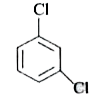What is the number of monochloro substituted derivatives formed from diphenyl methane?
The correct Answer is:4
To determine the number of monochloro substituted derivatives that can be formed from diphenylmethane, we can follow these steps:
Step 1: Understand the Structure of Diphenylmethane
Diphenylmethane has the following structure:
- It consists of a central carbon atom (the methylene group, -CH2-) bonded to two phenyl groups (C6H5).
- The structure can be represented as:
C6H5|CH2|C6H5
Step 2: Identify Possible Substitution Sites
In diphenylmethane, the central carbon is bonded to two phenyl groups. The positions where chlorine can be substituted are:
1. The carbon atom of the methylene group (CH2).
2. The ortho positions of the two phenyl groups.
3. The meta positions of the two phenyl groups.
4. The para positions of the two phenyl groups.
Step 3: Analyze Symmetry
Since diphenylmethane is symmetrical, substituting chlorine at the same position on either phenyl group will yield the same derivative. Thus, we need to consider unique substitution positions:
- Substituting chlorine at the methylene carbon (1 position).
- Substituting chlorine at the ortho position of one phenyl group (2 unique positions).
- Substituting chlorine at the meta position of one phenyl group (2 unique positions).
- Substituting chlorine at the para position of one phenyl group (1 unique position).
Step 4: Count Unique Monochloro Derivatives
Now, we can summarize the unique positions:
1. Substitution at the methylene carbon (1 derivative).
2. Substitution at the ortho positions (2 derivatives).
3. Substitution at the meta positions (2 derivatives).
4. Substitution at the para positions (1 derivative).
Adding these up:
- 1 (methylene) + 2 (ortho) + 2 (meta) + 1 (para) = 6 unique monochloro derivatives.
Conclusion
The total number of monochloro substituted derivatives formed from diphenylmethane is 6.
---
Diphenylmethane has the following structure:
- It consists of a central carbon atom (the methylene group, -CH2-) bonded to two phenyl groups (C6H5).
- The structure can be represented as:
C6H5|CH2|C6H5
In diphenylmethane, the central carbon is bonded to two phenyl groups. The positions where chlorine can be substituted are:
1. The carbon atom of the methylene group (CH2).
2. The ortho positions of the two phenyl groups.
3. The meta positions of the two phenyl groups.
4. The para positions of the two phenyl groups.
Since diphenylmethane is symmetrical, substituting chlorine at the same position on either phenyl group will yield the same derivative. Thus, we need to consider unique substitution positions:
- Substituting chlorine at the methylene carbon (1 position).
- Substituting chlorine at the ortho position of one phenyl group (2 unique positions).
- Substituting chlorine at the meta position of one phenyl group (2 unique positions).
- Substituting chlorine at the para position of one phenyl group (1 unique position).
Now, we can summarize the unique positions:
1. Substitution at the methylene carbon (1 derivative).
2. Substitution at the ortho positions (2 derivatives).
3. Substitution at the meta positions (2 derivatives).
4. Substitution at the para positions (1 derivative).
- 1 (methylene) + 2 (ortho) + 2 (meta) + 1 (para) = 6 unique monochloro derivatives.
The total number of monochloro substituted derivatives formed from diphenylmethane is 6.
Similar Questions
Knowledge Check
Which of the following substituted benzene derivatives would furnish isomer when one more substituent is introduced ?
A B
B C
C D
D
Fish derive oxygen from .
View SolutionThe number of possible monochloro derivatives of 2,2,3,3-Tetramethylbutane is -
View SolutionOnly two isomeric monochloro derivatives are possible for
View SolutionUrea is derived from
View SolutionTotal number of monochloro derivatives obtained by monochlorination of 2-methylepentane is
View SolutionBast fibres derived from
View SolutionWhich of the following compound can form during the free radical chlorination of methane?
View Solution

 Total number of monochloro structure products
Total number of monochloro structure products